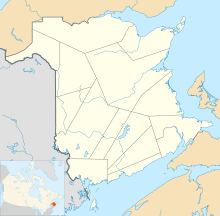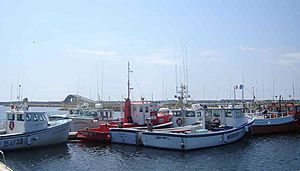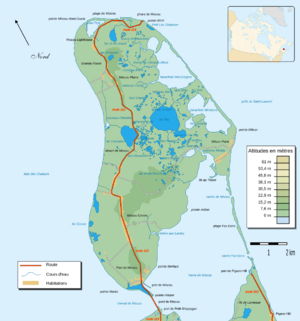Miscou Island facts for kids
Miscou Island (which is Île Miscou in French) is a beautiful island in Canada. It's located at the very northeastern tip of New Brunswick, right in the Gulf of Saint Lawrence.
Miscou Island is next to Lamèque Island. A narrow waterway called the Miscou Channel separates them. Together, these islands create a sheltered area known as Miscou Harbour. They also help separate Chaleur Bay from the larger Gulf of Saint Lawrence.
The name "Miscou" comes from the Micmac word "Susqu." This word means "low land" or "boggy marsh." This name fits the island well, as it has many open bogs.
In 1996, the Miscou Island Bridge was built. This bridge connects Miscou Island to Lamèque Island. Before the bridge, people used a ferry to cross the Miscou Channel. The bridge makes it much easier to travel between the islands.
Contents
Exploring Miscou Island's Past
Miscou Island has a long and interesting history. It was one of the first places explored by Europeans in Canada.
Early Explorers and Settlers
The famous explorer Jacques Cartier visited the Miscou Island area in 1534. Around the same time, Basque fishermen used the island as a base for their fishing trips. In 1634, a Jesuit mission was set up at Miscou Harbour. For many years, Miscou was an important trading port, especially during certain seasons.
Local Indigenous people had a legend about a monster called GouGou. They believed this monster lived on Miscou Island and were very afraid of it. However, they still visited the island each year to set up seasonal hunting camps.
The first person to settle permanently on Miscou Island was John Campbell. He came from Scotland around 1817. Other families soon followed, including Robert Harper, John Marks, Thomas Cowan, and Andrew Wilson. Later, fishermen from the Isle of Jersey and Acadian families also settled on the island.
A Famous Crash Landing
On April 28, 1939, something exciting happened on Miscou Island. A Russian pilot named Vladimir Kokkinaki was flying a special plane. He was trying to fly non-stop from Moscow, Russia, all the way to New York City! But he had to make an emergency landing on Miscou Island. This event became famous as the "Moscow-New York non-stop flight."
Life and Nature on Miscou Island
Miscou Island is home to a small community and amazing natural beauty.
Island Life and Economy
In 2011, about 585 people lived on Miscou Island all year round. Most of them speak French, but about 20 percent speak English. If you visit in the summer, you can find a helpful tourism information center at Miscou Harbour.
The main job on the island is fishing. Fishermen mostly catch lobster and herring. Unlike some nearby areas, the island's peat moss is left in its natural state. There are special boardwalks and information spots where you can learn about the peat moss and other unique habitats.
The Miscou Island Lighthouse
One of the most famous landmarks on the island is the Miscou Island Lighthouse. It was built in 1856 and stands tall at the very northeastern tip of the island. In the summer, you can take guided tours inside the lighthouse. It was recognized as a National Historic Site of Canada in 1974.
Nature and Fun Activities
Miscou Island is known for its beautiful sand dunes and lagoons. Many different migratory birds visit the island, including the rare piping plover. This makes Miscou a fantastic place for birdwatching and for people who love nature.
In 2010, Miscou Island won a special "Phoenix Award." This award celebrates great efforts in conservation for tourism in North America. The island was even called "one of the single most beautiful spots in the world."
Miscou is also a popular place for exciting water sports. People enjoy kitesurfing, kayaking, and sport-fishing for striped bass.
See also
 In Spanish: Isla Miscou para niños
In Spanish: Isla Miscou para niños




